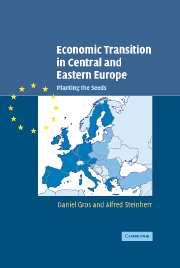Book contents
- Frontmatter
- Contents
- List of figures
- List of boxes
- List of tables
- Acknowledgements
- Introduction
- Part I The rise and decline of communism: an overview
- Part II Transition: 1990–2000
- Part III Extreme cases for reform: scope for disagreements
- Part IV The new Europe from the Atlantic to the Urals
- 9 From transition to integration: joining the EU
- 10 Saving the Balkans
- 11 The outlook
- References
- Index
9 - From transition to integration: joining the EU
Published online by Cambridge University Press: 05 June 2012
- Frontmatter
- Contents
- List of figures
- List of boxes
- List of tables
- Acknowledgements
- Introduction
- Part I The rise and decline of communism: an overview
- Part II Transition: 1990–2000
- Part III Extreme cases for reform: scope for disagreements
- Part IV The new Europe from the Atlantic to the Urals
- 9 From transition to integration: joining the EU
- 10 Saving the Balkans
- 11 The outlook
- References
- Index
Summary
The collapse of socialism in Eastern Europe transformed the economic and politic parameters of the European continent. Creating market economies was not the only hope that arose after the liberating events of 1989–90. Indeed, the basis for any analysis of the future of the transition countries must be that most of the countries west of the FSU made their choice early on: they wanted to join the European Union (EU). Since it was not possible for them to join the EU immediately, a transitional arrangement for trade was created in the early 1990s. Section 1 describes the transitional arrangements and section 2 provides a theoretical framework for judging their utility as a bridge to EU membership.
The EU is much more than a free trade area. If it were only that, the case for joining the EU rather than opting for worldwide free trade would be greatly weakened. The EU offers an integrated single market underpinned by a single currency – with free movement of capital and labour – supported by institutions that make the single market work and provide an indispensable common regulatory framework plus a solid monetary policy. How does this affect the choice of the applicant countries? The strength of this institutional framework makes membership particularly attractive for countries that have had only a decade to build market institutions, or, in some cases, simply did not exist before 1990.
- Type
- Chapter
- Information
- Economic Transition in Central and Eastern EuropePlanting the Seeds, pp. 263 - 302Publisher: Cambridge University PressPrint publication year: 2004



